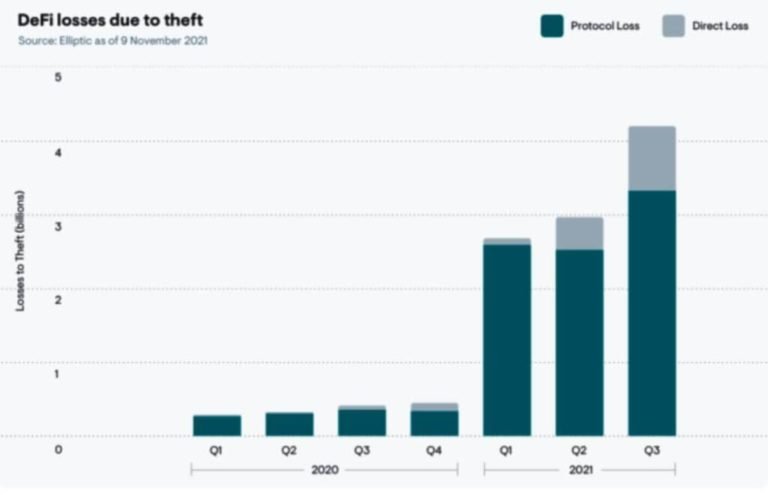DeFi crime has grown manifold in 2021 compared to previous year. According to a new report titled “DeFi: Risk, Regulation, and the Rise of DeCrime“, losses due to theft and fraud in DeFi space are accelerating, with losses totaling $10.5 billion in 2021 to date, up from $1.5 billion in 2020.
Decentralized finance (DeFi) has quickly become a flourishing alternative financial system that replaces traditional intermediaries with software running on blockchains.
Read Also: Mastercard Advances In Crypto Economy With CipherTrace
According to new research by Elliptic, the global leader in cryptoasset risk management, these losses have been suffered by investors and users due to the malicious exploitation of flaws in decentralized applications (DApps) such as decentralized exchanges (DEXs), lending protocols and asset management offerings.
The report also finds that these losses include direct loss of funds stolen from DApps, as well as losses suffered by holders of tokens associated with these protocols.
DeFi platforms have become increasingly popular in recent years, fuelling a boom in cryptoasset use. The “total value locked” (TVL), a measure of the liquidity of DeFi services, increased by a factor of nearly 500, from $500 million in November 2019 to just over $247 billion today.

This rise in popularity of DeFi has attracted a significant increase in associated DeCrime, a term coined by Elliptic to denote financial crime that involves decentralized financial tools such as DApps.
Losses due to theft and crime across DeFi platforms have increased by 600% from 2020, with $10.5 billion being stolen since the beginning of 2021 compared with $1.5 billion last year. More than $12 billion in total has been lost due to malicious exploitation of DeFi.

According to the report, DApps on Ethereum have seen the bulk of these losses, at $8.6 billion, reflecting its current status as the blockchain of choice for DeFi. However, Binance Smart Chain (BSC) has also seen significant theft and fraud, totaling $2.5 billion.
Tom Robinson, Chief Scientist at Elliptic, said:
“The DeFi ecosystem is an incredibly exciting and fast-moving space, with financial services innovation happening at light speed. This is attracting large amounts of capital to projects that are not always robust or well-tested. Criminal actors have seen the opportunity to exploit this.”
According to the report, the prevalence of DeFi theft and crime is largely due to the untested and immature nature of the technology available. Mistakes in the design and development of decentralized apps are the most common cause, giving rise to bugs which hackers can exploit, accounting for $10.8 billion of all losses. Another $1 billion in losses are the result of exit scams (where a DApp creator intentionally leaves a ‘backdoor’ in the code that allows them to steal users’ funds) and the theft of “admin keys”.
“Decentralised apps are designed to be trustless in that they eliminate any third-party control of users’ funds. “But you must still trust that the creators of the protocol have not made a coding or design mistake that could lead to a loss of funds.”
Robinson
Read Also: TRM Labs integrates Hedera Public Ledger to strengthen AML CFT capabilities
The report concludes that DeFi is likely to become an increasingly important part of our financial system, making financial services more accessible, efficient and competitive. But we are still at the experimental stage and DeFi users face significant risks.
Robinson believes that as the DeFi technology matures and becomes better-regulated, losses will fall and DeFi will become a practical alternative to the banks, asset managers and exchanges that we currently rely upon.



